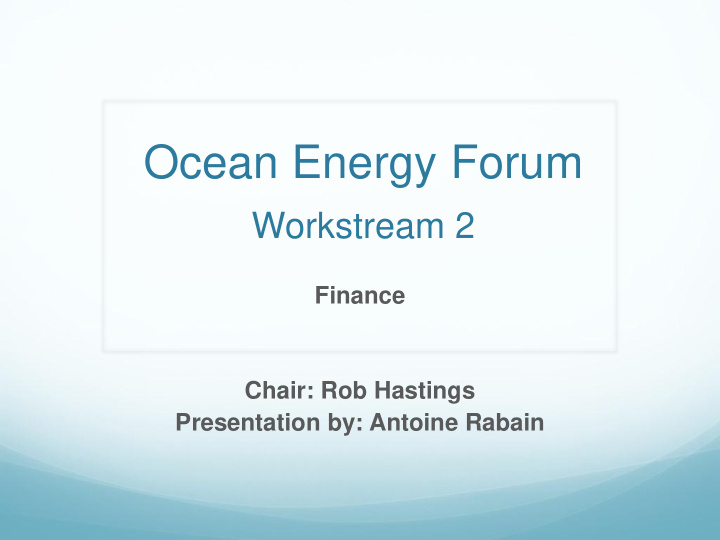



Ocean Energy Forum Workstream 2 Finance Chair: Rob Hastings Presentation by: Antoine Rabain
1. Givens Most MRE very early, so uncertainties over risk and finance. Drivers include prioritization by EU in renewables, need for pipeline projects, roll out by 2020, 100 GW is possible with right support. Industry has over-promised and under-performed in the past – poor incl. getting message across, lack of common understanding, but possibly due to the nature of finance available to the industry. Political risk aspects over rising costs. Issue is lack of support for 2030 renewables target. Will need to work towards competitive technology, with all forms of energy, esp. for heating. Is a lack of collaboration and an acknowledged need for collaboration.
2. Decisions to be made Need for public and private funding Make case for investment e.g., for utilities , how it is structured, crowd funding models, consortia structure. Needs to be different structures for waves and tidal investments Need to be local links e.g., benefits, jobs, etc to engage local communities / supply chains. Uncertainties around cost, so need completed arrays and possible cost-reduction / risk mitigation Need to reduce insurance costs and risk
3. Opportunities Need for clear standards, best practice and capitalizing on existing facilities. Many additional benefits e.g., jobs, lower electricity costs Lets not reinvent the wheel – tools are similar to previous emerging industries. Technology gains and IRR increases. Learning from carbon capture Collaborative investment from ‘super fund’, consortia approaches, other cooperative approaches etc. Crowd funding, great opportunities, but needs further consideration, esp. over suitability for different scales of investment
4. Threats Crowd funding might not suit all opportunities, esp. loss of public confidence from early failures. State aid and grant conditionality – finance must fit the project, not vice versa. Technical risks: need to get it right, impacts insurance, 3 rd party verification, etc Competition and costs (from other renewables, inc. shale and nuclear). Is also support form other areas e.g., Canada which might be a threat. Threat of competition between Member States, which limits whole market. Need to be pan-European in planning and captialise on MS strengths Social acceptance – early popularity may be lost is poor decisions are made now.
Value drivers Value Driver (score) 1. Risk understood and managed throughout the supply chain (3) 2. Money ‘fit for purpose’ e.g., compatibility issues with FP7 and Horizon 2020 which reduces incentives for uptake (15) 3. Develop and maximise the supply chain (0) 4. Develop consortium approach model (4) 5. Demonstrate local content and value (1) 6. Accelerating grid access (6) 7. Quick delivery of first project (20) 8. Visibility of staged and transparent plan (0) 9. Demonstration of effective technology – get arrays in the water (1) 10.Creating the conditions to allow roll out of technologies e.g., consenting, tariffs, etc by 2020 (2) 11.Role for MS & EC to actively encourage private investors to engage e.g., provide match funding (1) 12.Political commitment (9)
Value drivers and critical success factors Value Driver Critical success factor • Quick delivery Need for state intervention through grant funding at this of first project initial stage (provides legitimacy) • Adequacy of capital grant support • Conflicting investment offers • Technology robustness and novel investment risks • Ability for SMEs to offer performance / output guarantees • Long-term security of market and MS commitments • Need to use established infrastructure where possible to reduce risk • Favourable consenting environment
Decision roadmap Value <2020 <2030 <2040 <2050 Driver • • Decision Attract people into Local acceptance • investment Sustainable supply • Investment structures chain • • Diversification of wave Standardisation of & tidal technology • Insuring developments Owner Action needed Results required
Recommend
More recommend